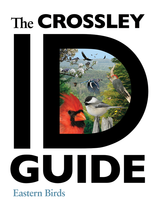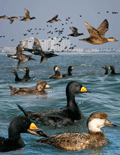
To most birders, having been brought up on a diet of the standard fieldguides of Peterson, Heinzel/Fitter/Parslow, the Shell guide, Sibley, the Collins guide and, of course, the mighty "Large" Jonsson, the first reaction on opening this new field guide to the birds of eastern North America may be something along the lines of "woah!" The style of presentation is so different, that it feels like a mental gear-shift is required to comprehend exactly what it is you’re looking at. And then you get sucked in...
Richard Crossley's book (published by Princeton University Press) is an incredible piece of work. There have been several field guides over the years that have claimed to present a new approach, but this one really does so. There are two reasons that this guide stands out. The first is the novel approach to presenting the photographs. For each species, a selection (often a sizeable selection) of photos are shown superimposed against a background habitat photo. However, the bird photos have been positioned and appropriately sized within the background image so as give both perspective but also, in the intention of the author, a more real-life birding experience. Inevitably, the scenes are not quite lifelike. In fact, some are so full of birds in a single view that the impression is more that of a surreal birder's dream, in which the sky is full of Cooper's Hawks, for example, all at different ranges and of different ages. But it's not sensible to get hung up on the fact it’s not 100% realistic – it's a field guide and it's there to learn from. There's a relatively small amount of text below each set of photos, although on a quick skim, this looks extremely well-focused and is useful in pinpointing key differentiating features. Crossley writes in an informal but concise style. There are also good distribution maps, along with some brief but focussed notes on status (e.g. I didn’t know that Smooth-billed Ani had become so localised in Florida).
 The second amazing thing is that the vast majority (over 99% apparently) of the photos were taken by the author. It really is an incredible quantity of work for one person to have generated. Amazing enough for one person to have generated decent portraits of each species in the region. But there are so many photos of each species, depicting different plumages, different behaviours, different stances. Crossley says that it was the flight photos that were often the real challenge. Clearly his residence at Cape May has been a huge help here, but a field guide with five different flight photos of Nashville Warbler is certainly different! I don't know enough about the American avifauna to know how many of these flight shots are likely to be useful to the novice birder for identification purposes, but it's still pretty cool to have them all included and it is a great resource to have in one place.
The second amazing thing is that the vast majority (over 99% apparently) of the photos were taken by the author. It really is an incredible quantity of work for one person to have generated. Amazing enough for one person to have generated decent portraits of each species in the region. But there are so many photos of each species, depicting different plumages, different behaviours, different stances. Crossley says that it was the flight photos that were often the real challenge. Clearly his residence at Cape May has been a huge help here, but a field guide with five different flight photos of Nashville Warbler is certainly different! I don't know enough about the American avifauna to know how many of these flight shots are likely to be useful to the novice birder for identification purposes, but it's still pretty cool to have them all included and it is a great resource to have in one place.
 So, it's a huge amount of work and it's a novel guide. But is it any good? I suspect some will hate it, but I think it's great. There's such a lot of information in here that I'm sure one would go on learning from it for years. The range of photos really allow an appreciation of jizz, but also of the appearance of the species in real-field conditions, sometimes distant, sometimes partially obscured, sometimes with heavily-worn plumage. I enjoyed searching through the background of each picture, looking for more hidden individuals; there's a presumably very real-life view of a Black Crake for example!
So, it's a huge amount of work and it's a novel guide. But is it any good? I suspect some will hate it, but I think it's great. There's such a lot of information in here that I'm sure one would go on learning from it for years. The range of photos really allow an appreciation of jizz, but also of the appearance of the species in real-field conditions, sometimes distant, sometimes partially obscured, sometimes with heavily-worn plumage. I enjoyed searching through the background of each picture, looking for more hidden individuals; there's a presumably very real-life view of a Black Crake for example!
One of the only potential downsides is that it is a reasonably hefty book, not something that could be stuck in a jacket pocket. However, it should fit effectively on the dashboard of a standard American gas-guzzler! And you can buy The Crossley ID Guide – Eastern Birds from the BUBO Store – what are you waiting for...?

